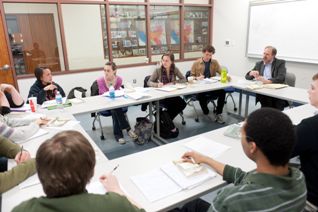Teaching and learning, an intersection of ideas

Teaching and learning, an intersection of ideas
September 19, 2017
Last summer, I reconnected with Mrs. Mateyka, my eleventh grade English teacher, over a cup of coffee. There I was, a college English major sitting with the woman who inspired me to choose this path years ago. We discussed everything, from school to work to the newest books we were reading. But above all, we talked about teaching and learning—how though they are confined to the classroom, both take place in every aspect of our lives.
What do we think about with regards to teaching and learning? Is it a classroom? A professor? An endless stack of homework? Or are they something more and extend beyond the confines of four walls and traditional definitions? I would argue the latter, for teaching and learning are not one-way streets. Rather, both are at an intersection, a space where the teacher can learn and the student can teach. It is here that each party can introduce the other to new perspectives, and make them question their previously-held beliefs.
There will always be that one teacher who we will always remember. A teacher who introduced us to ideas we’ve never encountered before, who was tough on us because they believed we could do better, who encouraged us to push ourselves because they knew we would succeed.
For me, this teacher was Mrs. Mateyka, whose British Literature course I took as a high school junior. In this class, we read everything from Oscar Wilde’s “The Picture of Dorian Gray” to Douglas Adam’s “The Hitchhiker’s Guide To The Galaxy” to my personal favorite, William Shakespeare’s “Hamlet.” Mrs. Mateyka was definitely tough, encouraging our class to read closely and dig deep when writing our papers. But she also made us love what we read, wrote and did—she motivated each student to be proud of the work they put forth.
This semester, I am a teacher’s assistant for a freshman English class. I was incredibly excited to have this opportunity because I took that same course four years ago. To bookend college with the experience that has led me to where I am now, and to see how my perspectives have changed since then has shown me that I have much to contribute to these students.
However, it has also shown me how much more they have to teach me about what I think, how I think about it and why I possess this world view. Though there aren’t many years between us, these students know of and understand things I have yet to encounter. And they have asked questions about literature and writing that make me stop and truly examine their viewpoints beside my own.
Through teaching, we learn a lot about ourselves and how we look at our world. As a teacher, you are presenting a certain perspective to your students, one that you identify and agree with. Yet your students also have the ability to challenge this perspective. We live in a fast-paced, ever-changing time, so there will always be new knowledge out there to encounter. And so, interacting with the individuals who are immersed in this environment is the best way to learn.
Villanovans, I encourage you to teach. Be it in a formal or informal setting, through tutoring or simply having a conversation with someone new, teach. You’d be surprised how teaching and learning can happen everywhere at every point throughout our lives. For sometimes, the lines blur so that the student becomes the teacher, and the teacher becomes the student.









